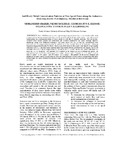Soil heavy metal concentration patterns at two speed zones along the Gaborone-Tlokweng border post highway, Southeast Botswana

View/
Date
2006-06Author
Shaikh, M.
Moleele, N.
Ekosse, G.I.E.
Totolo, O.
Atlhopheng, J.
Publisher
JASEM http://www.ajol.info/index.php/jasem/article/view/43693/27216Type
Published ArticleMetadata
Show full item recordAbstract
Since 1988 Botswana has been experiencing an unprecedented increase in vehicular traffic which
is suspected to be having contamination effects on soils along heavily used roads in the country. This study aimed at
understanding the contamination trends of heavy metals on soils due to vehicular emissions. The soil physicochemistry
(bulk density, particle size distribution, pH, electrical conductivity and cation exchange capacity),
mineralogy (using x-ray diffraction techniques) and heavy metals (Cd, Pb, Cu and Zn) concentrations were
determined for soil samples obtained along the roadside at 2m, 4m, 6m and 100 m of the Gaborone – Tlokweng
Emigration/Immigration Boarder Post Road, which is one of the busiest in the country. Bulk density of soil samples
were from 1.19 to 1.4; and sand, loamy sand and sandy loam textural classes constituted the soil samples. The soil pH
was from 5.09 to 8.57; the EC ranged from 6.27 μS cm-1to 20.3 27 μS cm-1 and the CEC values were from 10.2
meq100g-1 to 27.2 meq100g-1. Clay minerals were identified in the samples as well as feldspar and quartz. The
concentration levels for Pb were from 0 mgkg-1 to 71 mgkg-1; Zn were from 5.23 mgkg-1 to 51.26 mgkg-1 ; Cu were
from 0.3 mgkg-1 to 18.1 mgkg-1 and Cd 0 mgkg-1 to 2.4 mgkg-1 . The interplay of soil physico-chemistry and
mineralogy on heavy metals concentrations is discussed. Although levels of heavy metals concentrations fell below
normal ranges, the values obtained were generally higher than those from some developed and developing countries.
